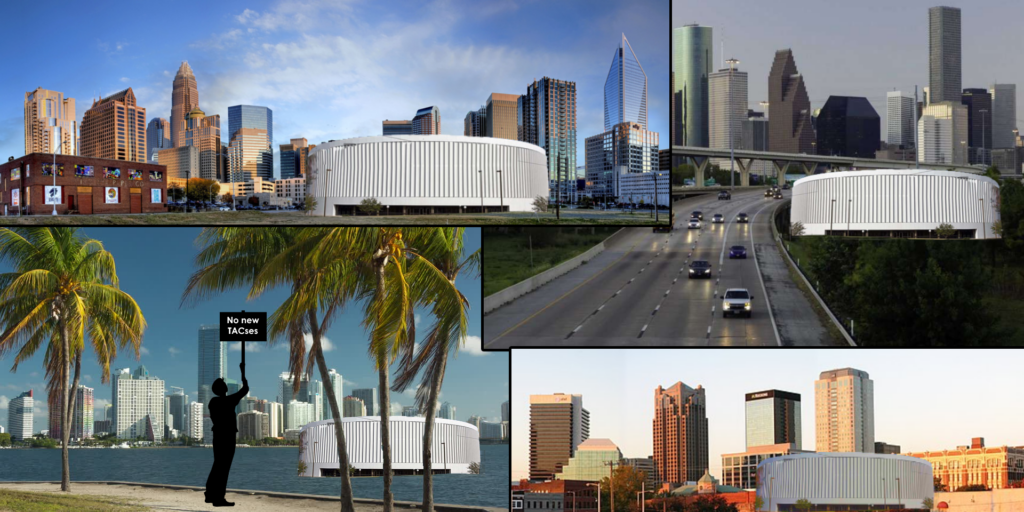It’s no secret that the Louisiana Tech men’s basketball team has struggled away from home this year. Outside of the Thomas Assembly Center, Tech is 3-9 (0-6 in C-USA). On their home floor, the Bulldogs have yet to falter, recording a 12-0 record.
But what makes the TAC so special? On average, fewer than 2,300 Tech fans file in to the 8,000 seat arena to watch each basketball game. I’m not saying the crowds aren’t helping. But surely they can’t be the only explanation of Tech’s home success.
Maybe the victories at home are a product of the Bulldogs sleeping in their own beds the night before the game. No travel itineraries. No shoot-arounds at foreign courts.
But I believe the TAC building itself is the culprit. Tech is able to draw some sort of mystic energy from the structure itself that is allowing them to win more basketball games.
Maybe the arena is cleansing the air of bad basketball juju. I mean, why else would the thing look like a giant air filter?

So if it’s the TAC itself that’s special, then firing the coach won’t bring success. Benching Powell won’t bring success. Somehow finding another year of eligibility for Karl Malone won’t bring success.
What would turn this season around is if we could play more games in the TAC. If Tech played every game at home, they’d easily run away with the conference. But C-USA dictates that certain games must be played on the road, in the towns of the other selfish schools. But the Conference doesn’t dictate in which arena those games must be played.
So here’s the plan: Build 13 replicas of the Thomas Assembly Center in each C-USA town for Tech to play in when they have to travel for a basketball game.
But how would we force the road games to move to these copycat TACs? Why would a team like Southern Miss choose to play away from the Reed Green Coliseum?
If Carmen Sandiego can steal the Strait of Magellan, I’m sure she can pull off a heist of some basketball arenas.
So now that the former C-USA arenas have somehow vanished overnight, we can start doing some math. When it was constructed in 1982, the TAC cost roughly 17.5 million to build. So to build 13 TACs, we multiply $17,500,000 × 13 to get $227,500,000 (or just over 10 Davison Athletic Complexes).
But being able to build the arenas doesn’t mean anything if we aren’t able to place them in the right towns. We have to buy the land to place the buildings on.
The OG Thomas Assembly Center takes up roughly 2.3 acres, not including parking lots:

We aren’t too concerned about parking, because most of the attendees of these games are away fans. Why should we make it easy for non-Tech fans to attend anyway?
Okay, so we need to buy 2.3 acres of land in 13 different cities close enough to the college campuses so C-USA can’t tell the difference. Using Zillow, I found land plots that fulfill these criteria:

Sources: Rice ODU FIU Char FAU USM UTSA UNT MTSU UTEP UAB WKU MU
That’s a grand total of $4,556,700 in real estate.
Now you might be wondering: What about zoning laws? What if the smaller plots aren’t square shaped? What about inflation on that 17.5 million dollar figure from 1982 to build a TAC?
I will address none of these concerns.
Adding everything up, we have $227.5 million in construction cost and $4.6 million in land acquisition for a total of $232.1 million.
Even if it was a guaranteed success, is this plan really worth 232 million dollars? Couldn’t we spend this money in better places? Think of all the good we could do with 232 million dollars.
But also think about how many conference wins the basketball team could have. Think with your heart not your head: you know this must be done.
Coming up with 232 million dollars is not easy. We could start a GoFundMe, but that might only get us about 2% of the way to our goal.
To make up the rest of the difference, we need to cash in the University Endowment, which currently sits at about 99.5 million dollars. This isn’t quite enough, but luckily we have friends in the UL System.
If we combine the endowments from all nine UL schools (minus ULL and NSU because let’s be realistic), the total jumps to 310.9 million dollars, more than enough to fund this worthwhile expenditure.
And I’m sure those other schools will be on board.
With the way every school in C-USA is performing on the road this year, I’m honestly surprised nobody has done this before.

